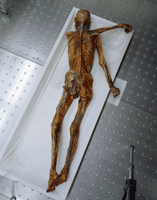
The 5,300-year-old mummy–dubbed “Ötzi the Iceman”–found frozen in the Alps in 1991 made headlines again in 2007. Researchers at the South Tyrol Museum of Archaeology in Bolzano, Italy, where Ötzi’s remains are housed, conducted CT scans that revealed exactly how he died: an arrow to the back pierced an artery; basically, he bled to death. Although X-rays and CT scans carried out in 2001 showed that an arrow had been wedged in his shoulder, this new evidence suggests the arrow inflicted the fatal blow (after which, the poor guy fell, hit his head, and suffered a brain hemorrhage).
For more than 15 years, scientists have been reconstructing every detail of Ötzi’s life, down to the contents of his last meal. One of their most interesting findings was that the Iceman sports some of the world’s oldest tattoos, most of which resemble blue-black hash marks. Many tattoo artists feel they are carrying on his tradition even today, a phenomenon that may have had a role in another significant story this year.
For more interesting topics related to archaeology, visit archaeology excavations.
1 comment:
I was looking for more information re: the artifacts that were with Otzi when he died.
Two things have always mystified me about this case:
1) Otzi is presumed to have died in the Spring/Summer. If then, in the middle of an Alpine Summer, then why wasn't there more decay? It would seem to me that despite the pollen ingestion, that common sense would lead us to believe that Otzi would have died in the later Autumn/early Winter when the snows would have covered him and preserved him.
2) Many have assumed that Otzi was murdered on the site or near where he was found. If so, why weren't his artifacts taken? Is it not more plausible that he may have been attacked at a lower altitude, then in his weakened state retreated to the higher ground, an area which he may have been more familiar with and, where he may have stored other artifacts (the ones he was discovered near). It seems more logical that he was attacked and sustained life-threatening wounds elsewhere, then returned to a location where he felt safer and one in which he already had the axe, bow & quiver, etc. hidden away from others. The attackers would have just seen him as running away from where the attack occurred, seemingly without any arms of any kind. Otzi retreats knowing that he needs to get back to his reserve of arms in case he is followed. He needs to produce more arrows however. His attackers never follow him, thinking he is mortally wounded and they don't need any more from him than they have already taken. Otzi's wounds are so pronounced that he dies before he can complete any further work, or he faints and falls off a rock, hits his head in the process and dies in the trench where he is covered with snow.
My thoughts.
I would love to know what else was recovered in subsequent "digs" on the site of his glacial interment.
Post a Comment